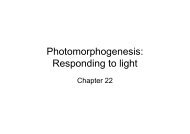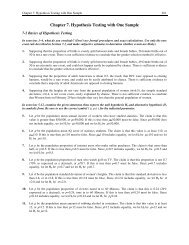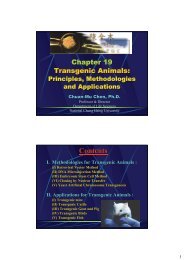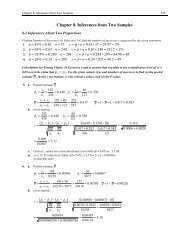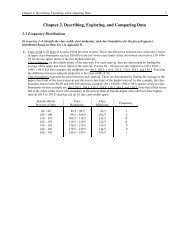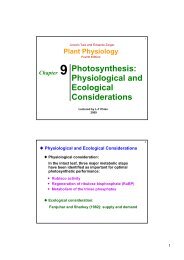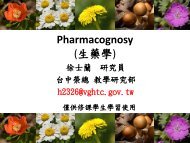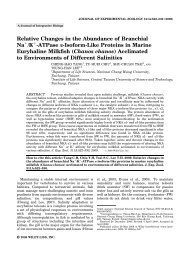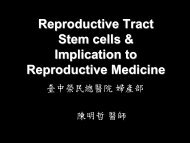Chapter 3. Probability
Chapter 3. Probability
Chapter 3. Probability
You also want an ePaper? Increase the reach of your titles
YUMPU automatically turns print PDFs into web optimized ePapers that Google loves.
66 <strong>Chapter</strong> 3: <strong>Probability</strong>19. Genetics: Sample Space, one with brown-brown and one with blue-blue, brown dominanta. Possible Outcomes, brown-blue= brown, brown-blue= brown, brown-blue= brown, brown-blue= brownnumber of ways blue eyes can occur 0b. P ( blue) == = 0. 000number of different possible outcomes 4number of ways brown eyes can occur 4c. P ( brown ) == = 1. 000number of different possible outcomes 420. Improving Effectiveness of a TreatmentIf the probability is 0.04 that the treatment group would show improvement when the drug is not effective, wewould conclude that it is likely the drug is effective. There would be a probability of 0.04 of being wrong inconcluding the drug was effective.3-3 Addition RuleDetermining Whether Events Are Disjoint. For each part of exercises 1 and 2, are the two events disjoint for asingle trial? (Hint: Consider “disjoint” to be equivalent to “separate” or “not overlapping.”)This is also referred as being “mutually exclusive” where both events cannot occur at the same time.1. a. Not disjoint, since a cardiac surgeon could also be a female physician.b. Not disjoint, since a female college student could also drive a motorcycle.c. Disjoint, since if a study subject received Lipitor, he/she could not also be in a control group that receivedno medication.2. a. Disjoint, since a fruit fly cannot have both red and sepia colored eyes.b. Disjoint, since a volunteer survey subject can both oppose all cloning and approve cloning sheep.c. Not disjoint, since a nurse could also be male.<strong>3.</strong> Finding ComplementsThe complement of the probability of an event is the probability that that even will not occur.The sum of a probability and its complement is equal to 1.a. If P(A)= 0.05, then P( A )= 1 – 0.05= 0.95b. If probability of having red/green blindness is 0.25% or 0.0025, then the probability of not having red/greenblindness is 1 – 0.0025= 0.9975.4. Finding Complementsa. If P(A)= 0.0175, then P( A )= 1.0000 – 0.0175= 0.9825b. If 61% believe in life elsewhere, then P(believe in life elsewhere)= 0.61 and P(do not believe)= 1.00 –0.610= 0.3905. Peas on Earth, based on Table 3-2P(green pod or white flower)= P(green pod) + P(white flower) – P(both green pod and white flower) = 8/14 +5/14 – 3/14= 10/14= 0.7146. Peas on Earth, based on Table 3-2P(yellow pod or purple flower)= P(yellow pod) + P(purple flower) – P(both yellow pod and purple flower) =6/14 + 9/14 – 4/14= 11/14= 0.7867. National Statistics DayP(birthday on Oct. 18)= 1/365, P(birthday not on Oct. 18)= 364/365= 0.997




